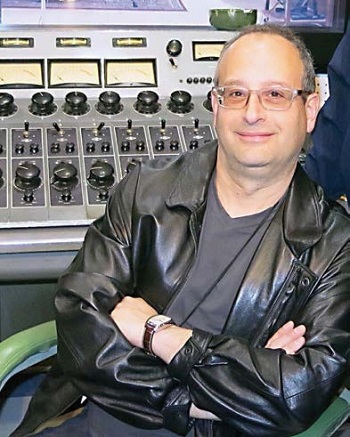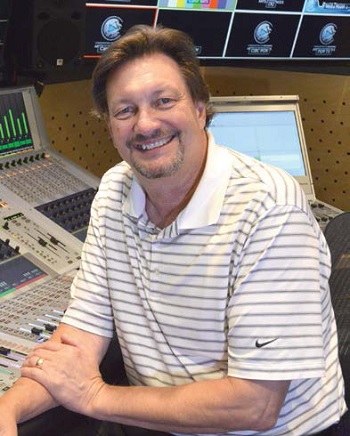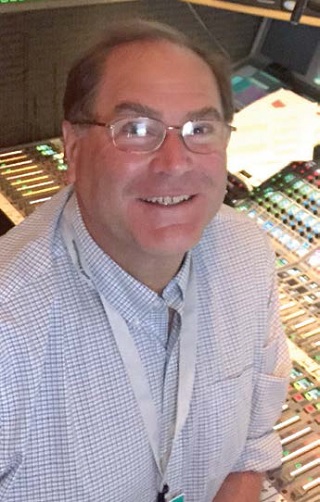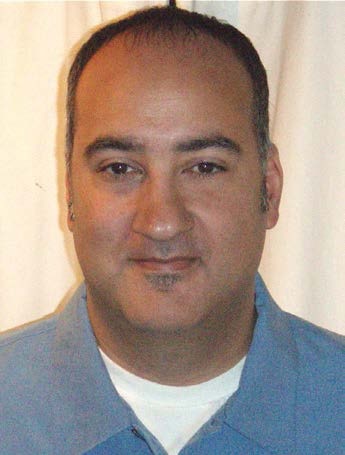The Art of Audio Mixing for Sports
NEW YORK—How difficult is it to mix audio for a major network sports event?
“Sit in front of your television,” said Phil Adler, a longtime broadcast mixer whose credits include five Olympics and a pair of Super Bowls. “Turn on your favorite show, then turn on a couple of radios and dial in two different talk radio stations; make sure to put them off to the left and right, or behind you, then bring both up in volume close to the TV show you’re watching. Oh, and turn on your laptop and start working on it at the same time! Now listen to what the director, standing on your right, has to say while the producer talking in your ear is making comments. Easy!”
TV Technology recently spoke with a panel of highly experienced sports audio broadcast engineers about the challenges they face and the developing trends in the industry. Joining Adler were Fred Aldous, senior mixer and audio consultant for Fox Sports, the recipient of 23 Emmy Awards and a recent inductee into the Sports Broadcasting Hall of Fame; four-time Emmy-winner Dana Kirkpatrick; and Paul Zerang, audio engineer for the Chicago Blackhawks NHL team.
TV Technology:What kind of sports events are you working on these days?
Aldous: I currently mix the “A” NFL game for Fox Sports with Joe Buck and Troy Aikman. As of late I have gotten involved with education. I consult with CRAS, an audio recording school in Arizona; I helped build the audio curriculum that is being taught today. Up until this past spring I mixed NASCAR on Fox for the past 15 years.

Phil AdlerAdler: I’ve been mixing live television sports events since 1988, for CBS, Fox and other networks. This will be my 21st year working with the NFL. I mix boxing for Showtime, have done five Olympics, and two Super Bowls. I work for CBS on one of their Sunday afternoon NFL games; they take about six months of my time. I also handle college basketball. I was a rock ’n roll mixer for 10 years before I got into sports audio.
Kirkpatrick: I freelance and work a variety of sports events, golf, mostly at ABC, and college football, plus figure skating, two Super Bowls, and the “Wide World of Sports.” I worked on golf for Fox this summer, and for the last four or five years had done a lot of work in London mixing gymnastics and ski events for the Olympics. This July I mixed the tennis Hall of Fame event in Newport, R.I.
Get the TV Tech Newsletter
The professional video industry's #1 source for news, trends and product and tech information. Sign up below.
TVT:What are the main issues confronting audio engineers who have to present both surround and stereo mixes in real time?
Kirkpatrick: The problem currently is that nobody has come up with the definitive way to do Surround Sound. All we’re told is that they want to broadcast in Surround Sound; we end up figuring out for ourselves how to get it done! Television trucks have to have a stereo program throughout. Monitoring in the truck is in stereo, since that’s still what the majority of people are listening to. Some audio mixers create a downmix by taking a 5.1 mix and running it through a Dolby DP563, and route that all around. I just create a stereo mix using a Calrec console by taking the output of the six groups and sending them to a stereo buss to create a pure stereo mix. Do these two approaches yield a different sound? That’s the rub, nobody really knows.
ESPN demands an upmix in circle sound. This fall in my studio I can—at the punch of a button—compare true stereo from stems with a Prologic-encoded stereo downmix; I’ll let you know what I find. Some mixers simply turn off the rears and that’s their “stereo” mix—the left and right speakers mix with the center. NBC is big on 3.0 upmixing. We use the left and right sides and keep the center channel discrete. No final standard is in place at this time.
Adler: Regarding mono to stereo, stereo to 5.1, and analog to digital, there are a number of painful transitions for live sports going on. Some things that work great in fi lm translate to television, but other things don’t. 3D, for example, can be very effective in fi lm, but it doesn’t work for sports. It’s been tried in football, without much success. Same thing applies to audio. In fi lm, a director is thinking about multichannel sound from the beginning, and has time in the post process to get things right. In the fast-paced world of live sports we don’t have that luxury. If you want surround audio, all you can do is slap on an algorithm.
Here’s what we face in live sports: Going from mono all the way up to 5.1, the challenge is to get as immersive as possible for the viewer while keeping the announcers and commentators clear and dominant. It’s a bigger challenge than ever now because of 5.1. With mono there’s not much the end user can do to muck up the sound. Some of these $300 receivers can do an automatic level adjust, but if you’ve got a small center speaker and larger left and right speakers, and an overcranked sub-woofer, the sound can be hideous! Viewers then call up the network and start bitching that they can’t hear the announcer; we have conference calls every week about this. There’s a 6 dB of separation between center channel [announcers] and everything else, but the way things are set up in a home the distinction can be lost.
How do I make the audio sound good? I do my homework, listen to a downmix, with commercials, listen at home, on a small desktop system in my office; it’s like listening to a record mix on a cassette and taking it into your car.

Fred AldousAldous: I do one mix; it is a 5.1 mix. The left/right downmix is created from the 5.1 stems. I have learned over the years by primarily listening to the downmix [of which most of the viewing audience does] what my 5.1 mix is doing. By having to listen to a director, producer, associate director, my comms panel and the mix, it becomes quite overwhelming to add a 5.1 mix to that; by listening to the left/right mix it helps eliminate some hearing fatigue.
TVT:Do different sports require different mixing techniques?
Aldous: Yes. I do two different types of mixes depending on the sport. For NFL I mix from a fan’s perspective sitting in the stadium, what I call the “observers mix;” I build a 360-degree sound bed of crowd (all Fox shows are in 5.1), in an effort to create the image of the fan sitting in the stadium. I do, though, take them to the field for the quarterback cadence, line hits and sideline camera angles. The field of play never leaves looking forward so all of my field effects are from that perspective.
For NASCAR I did what I called the “POV” or point of view perspective, taking the viewer to the cameras around the track. We [the audio team of submitters and A2’s] took the viewer trackside to the camera position and let the sound come through the room [front left to rear right]. Since most tracks are round or oval and the cars go counter-clockwise, the cars usually enter the frame from the left and leave the frame camera right. This creates a great effect.
Adler: Golf (which I don’t do much of) is very different from other sports. There will be a mixer who handles the microphones out on the golf course. He or she premixes and feeds them into the main mixer. The audio mix goes back and forth between what’s live and what’s been prerecorded. For example, the announcer will say, “Let’s go back to the 16th hole.” A submixer is sending the prerecorded audio back to the truck. The same thing goes for auto racing— sometimes there’s even a third guy who mixes in-car audio only.

Dana KirkpatrickKirkpatrick: I’ve experimented in gymnastics and figure skating; rather than using one or two upmixers, I’ve used four or five, so that I can mix crowd microphones, for example, and keep them separate from music. I create effects for each phantom center independently. What typically happens is that a gymnast will finish a routine and head off an apparatus, at which point the image collapses, because you’re crossfading from the microphones covering the station to the microphone on the handheld camera that’s following the athlete. The Audio-Technica BP4029 is able to maintain a 5.1 image while cross-fading from five or six crowd microphones to one handheld camera. Not many mixers are using this technique, but I find it to be very helpful in maintaining the surround image.
Gymnastics is one of my favorite sports to work on. Mixing audio for gymnastics is a game of managing the ambience levels so they’ll match when you go from a huge arena with a screaming crowd to a closeup of the gymnast walking off a piece of equipment. In football, the crowd noise is a constant, more or less, but to get the fine detail of a gymnast walking off an apparatus you have to close everything and only open the audio on the handheld camera, and that camera microphone has to have the same basic characteristics as the crowd mix or else the image will collapse. I handle that by using the stereo microphone on the Audio-Technica handheld and upmixing it and the crowd microphones separately. That way, I have control, and when I crossfade to the handheld camera microphone it’s matched in its characteristics with the crowd mics.
The same principle applies to figure skating. You’ll have a loud arena and the next moment you want to go to a coach and figure skater on the boards before the routine. To hear them you have to open up the handheld microphone and close down everything else, but you still need to maintain the wide image. I’ll EQ the handheld microphone so that I can crossfade and have the EQ and width sound very similar to my crowd microphone. This is what I’ve been doing for the past five years.
TVT:What tools do you rely on?

Paul ZerangZerang: I used Shure’s Axient Wireless System during the [NHL] Winter Classic and Stanley Cup Final for the Chicago Blackhawks, with the NHL’s great frequency coordination and Axient support. With these systems, we experienced full stadium coverage with no RF dropouts, even with all of the world’s media wireless crowding.
With Axient, the interference detection and avoidance is flawless, and its show link is also a very valuable tool. With its real-time remote control of the transmitter, the audio engineer can change frequencies from up in the booth instantly and monitor the battery level, gain control and RF muting.
The battery system is an advanced lithium-ion rechargeable battery that lasts much longer than anything I have ever used. Getting four hours in dual mode is pretty solid, as well as the charging stations if you want flawless wireless.
Kirkpatrick: I rely a lot on the A-T BP4029; I use it in the start house for ski racing, figure skating, gymnastics, and football. All of the Audio-Technica stereo microphones have the same characteristics, so it’s easy to blend between large diaphragm microphones and those on their handheld cameras.
I’m also a big fan of Calrec consoles. We use the extra headroom these boards have. I don’t even compress any more. With golf for example, there are certain things, like a driver hitting a ball, where you want every bit of level. I love everything about Calrec; the sound of their boards is excellent, they’ve got routing all figured out; the manufacturer is very easy to work with; and their software is constantly getting updated. The Artemis and Apollo are the two boards I work mostly with.
Adler: I use a lot of Audio-Technics stuff, depending on the sport. In football we use four to six parabolic wireless microphones that roam the sidelines, and microphones to pick up the crowd. Football is a bit more limited; I have used A-T stereo microphones for crowds. I have a variety of their stereo microphones. I use them for ring overheads in boxing, for example. Most of the time I’m mixing on a Calrec console.
